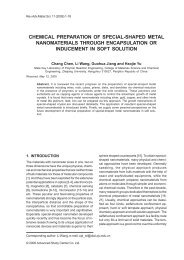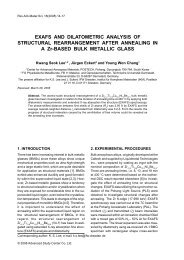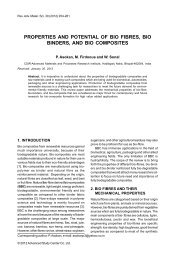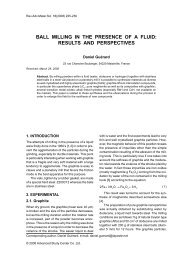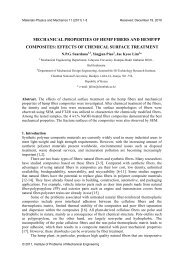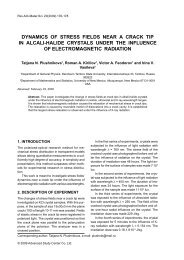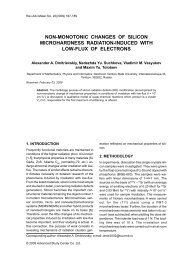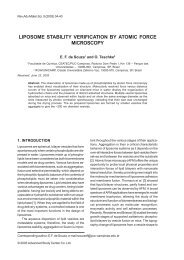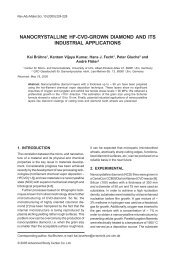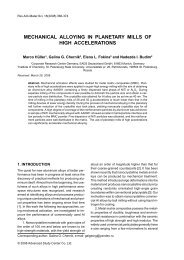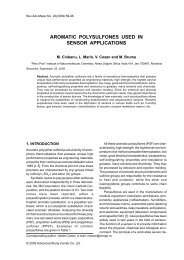surface pretreatment by phosphate conversion coatings – a review
surface pretreatment by phosphate conversion coatings – a review
surface pretreatment by phosphate conversion coatings – a review
You also want an ePaper? Increase the reach of your titles
YUMPU automatically turns print PDFs into web optimized ePapers that Google loves.
138 T.S.N. Sankara Narayanan<br />
3.4. Kinetics of the phosphating<br />
process<br />
Kinetics of the phosphating process reveals the<br />
steps involved in the course of phosphating and their<br />
rates. Three different methods have been used so<br />
far for investigating the kinetics of formation of <strong>phosphate</strong><br />
<strong>coatings</strong> namely: (i) the gravimetric method,<br />
<strong>by</strong> the quantitative determination of the quantity of<br />
<strong>phosphate</strong> deposited per unit time; (ii) the electrochemical<br />
method based on the determination of free,<br />
reactive uncoated areas through electrochemical<br />
passivation; and (iii) the radiographic method based<br />
on the determination of the intensity of the characteristic<br />
X-ray of the resulting compound.<br />
All the three methods gave a similar picture of<br />
the phosphating process that showed the coating<br />
formation did not take place in a linear fashion, rather<br />
it was initially very fast, after which the rate slowly<br />
decreased with time.<br />
Studies on the kinetics of phosphating indicate<br />
that there are four distinct stages in coating formation<br />
(Fig. 1), namely, the induction stage (α), the<br />
commencement of film growth (β), the main exponential<br />
growth stage (γ) and the stage of linear increase<br />
in film growth (δ). During the induction period,<br />
the oxide film remaining on the <strong>surface</strong> even<br />
after cleaning is removed. When film growth commences,<br />
the first nuclei are formed and the rate of<br />
nucleation increases rapidly with time. This, however,<br />
depends considerably on the conditions of the<br />
<strong>surface</strong>, the <strong>pretreatment</strong> procedures adopted and<br />
the oxidizing agents present in the phosphating bath.<br />
Growth occurs in the main exponential growth stage.<br />
Addition of accelerators reduces the induction period<br />
and extends the stage of linear growth.<br />
In the opinion of Gebhardt [162], the rate of phosphating<br />
depends on the rate of diffusion of Fe 2+ ions<br />
from the structural lattice to the coating/solution<br />
interface through the coating formed. Machu [25]<br />
has found that the rate of the phosphating reaction<br />
is a function of microanodes on the <strong>surface</strong>.<br />
-dF A /dt = K . F A dt<br />
where dt <strong>–</strong> change in time; F A <strong>–</strong> <strong>surface</strong> area of anodes<br />
in microcells; and K <strong>–</strong> reaction rate constant.<br />
The rate of formation of the <strong>phosphate</strong> coating<br />
depends primarily upon the metal viz., the ratio of<br />
anode <strong>surface</strong> which was initially present, F Ao , to<br />
the anode <strong>surface</strong> at any given moment, F A . The<br />
influence of various other factors controlling the rate<br />
of reaction, e.g., temperature, <strong>surface</strong> condition etc.,<br />
is reflected in the value of the rate constant K, which<br />
is different for different processes.<br />
Fig. 1. The various stages in the growth of <strong>phosphate</strong><br />
coating (in presence of accelerator).<br />
The overall coating growth process can be followed<br />
<strong>by</strong> potential-time curves (Fig. 2), which indicate<br />
the different stages of coating besides indicating<br />
when the effective phosphating has ceased.<br />
Correlation of potential-time relationships with film<br />
properties leads to the conclusion that coating formation<br />
proceeds through the following stages:<br />
(a) electrochemical attack of steel;<br />
(b) amorphous precipitation;<br />
(c) dissolution of the base metal;<br />
(d) crystallization and growth; and<br />
(e) crystal reorganization.<br />
But, in actual practice, it is difficult to identify the ‘b’<br />
and ‘c’ stages, and the curve mainly exhibits the<br />
process of metal dissolution, coating formation and<br />
coating completion. The use of potential-time measurements<br />
for monitoring the phosphating process<br />
was first described <strong>by</strong> Machu [25]. It has also been<br />
used <strong>by</strong> several workers to reveal the nature of the<br />
Fig. 2. Potential-time curve showing the various<br />
steps of phosphating.



